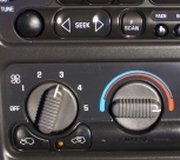First of all, your vehicle has to have come with air conditioning to have the water valve. It is in the heater hose, about 4" from the firewall. A small black vacuum hose attaches to it. On the other side, you'll see a small linkage hooked to a lever.
Even if the AC no longer works, you should see that linkage move when a helper switches the heater controls from heat to AC and back. The valve blocks hot coolant from entering the heater box when the AC system is being used. It opens to allow coolant to flow in the heat, defrost, and vent settings. The AC will also run in defrost mode to remove humidity from the air before it is blown onto the cold windshield where it would condense and cause fogging.
When you watch the water valve, the engine must be running to provide the vacuum to operate it. The valves give very little trouble but if you don't see it move, try to move the linkage by hand. I can never remember which way is open, but one way you should get good flow of hot coolant. It would be more common to find a cracked vacuum hose but the vent doors in the heater box are vacuum-controlled too so you would likely also notice the air is always blowing from the defroster vents. The system is spring-loaded to go to that mode in case of a vacuum supply failure. Your feet might freeze, but the windshield will be clear.
If the valve is switching, feel the heater hoses after the engine is warmed up. They should be too hot to hold onto for very long. Same is true of the upper radiator hose. If the radiator hose doesn't get hot, suspect a stuck open thermostat. If the radiator hose IS hot but the heater hoses are not, the most common cause is sediment plugging the heater core. One word of warning: if the heater core has been filled with sediment for a long time, it is possible for that crud to be blocking a leak. Once the sediment and corrosion are flushed out, the leak might show up, not because you caused it, but because you removed the blockage. That doesn't happen often but it's worth mentioning.
Caradiodoc
SPONSORED LINKS
Wednesday, August 4th, 2010 AT 9:01 PM



